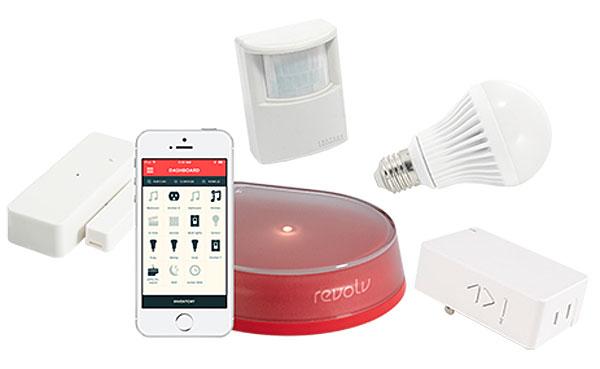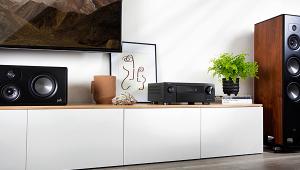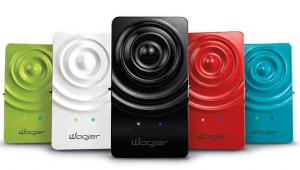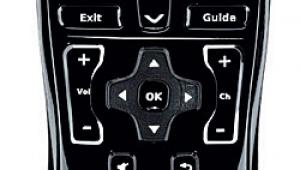Revolv Hub Home Automation Controller

AT A GLANCE
Plus
Seven radios built in
Extremely easy initial setup
Minus
Pricey next to other DIY automation hubs
Lacks some advanced programming features
THE VERDICT
The Revolv Hub is a powerhouse that looks to be relatively future-proof from a hardware standpoint. A great choice for a newbie.
Humble isn’t a word anyone would associate with Revolv and their distinctive, teardrop-shaped, little red smart-home controller—which the company calls, with uncharacteristic restraint, the Hub. In fact, this device is easily the flashiest and most recognizable of all the smart home gadgets around today. If you are to believe the Revolv-ers, it’s “the most powerful home automation hub on Earth.” In order to prevent unreasonably high expectations, though, Revolv adds that their Hub is “the most compatible yet dead simple, DIY solution for unifying, controlling, and automating all of your favorite connected home devices, regardless of brand, manufacturer, or protocol.” At $299, it can claim to be the most expensive of the new herd of DIY automation controllers as well, but Revolv is quick to point out that, along with all future updates, the price includes a lifetime subscription that provides ongoing remote access and GeoSense automation services (which uses the GPS in your phone to detect whether you’re at home or away).
Unlike most smart home controllers that are small, unadorned (but thankfully not black) boxes that get unceremoniously stashed next to a router, Revolv’s Hub is a 5.5 x 6.5-inch roundish gadget with a bright red base and a translucent plastic cover. If it didn’t have a skinny, white power-cord tail and the white Revolv logo on the side, you might mistake it for a snazzily designed Tupperware container that’s been flipped upside down. Inside the Hub are seven radios—about twice as many as found in most other sub-$300 controllers—and they’re a large part of the reason why the folks at Revolv feel they can make such bold claims about device and protocol compatibility. At the moment, however, only three of the internal radios are active: Z-Wave, Wi-Fi, and Insteon. If all goes as planned, the ZigBee radio will be active by the time you read this. The remaining three are “other proprietary radios [to be] supported in the future.”
A Flash in the Hand
The “flashiest” aspect of the Revolv Hub is the small LED centered on the top cover. Since the Hub is a wireless-only gadget without Ethernet or USB ports, you must connect it to your home network’s wireless router. In order to get the necessary Wi-Fi network password and parameters into the input-lacking Hub, Revolv has engineered a proprietary method that transfers the info stored in your iOS or Android device to the Hub using the smart device’s built-in camera flash. It’s unbelievably simple and lightning fast (typically under 60 seconds)—and it’s a convenience feature that you’ll appreciate even more if you install a new router (with potentially new SSID settings) in the future. From there, it’s a matter of setting up your Revolv account via the Revolv app, adding Devices, and creating what the company calls Actions.
Over-the-top marketing notwithstanding, just because Revolv’s Hub contains multiple active radios doesn’t mean it automatically supports every device using one of those wireless protocols. Many of the big name-brand smart gadgets are on Revolv’s list of supported devices, including Philips Hue, Insteon, Belkin WeMo, GE, Leviton, Aeon Labs, Honeywell, Trane, Kwikset, Schlage, Yale, and Somfy. But at the moment, disappointingly, not every device from those companies gets the Revolv Hub love. As with every other smart home controller, you can’t run out willy-nilly and buy any so-called smart device and expect the Revolv Hub to always say, “Welcome home!” (Revolv graciously provides a direct way of purchasing compatible devices from within the Revolv app.) To make things as easy as possible, some supported devices—from Sonos, Nest, Philips Hue, and Belkin WeMo—are automatically discovered in the background.
Revolv supports motion sensing with one model from Belkin WeMo and one from Insteon, but noticeably missing is support for any kind of environmental sensor (such as those for monitoring temperature, humidity, sound, light, or all of the above). During my evaluation, there was no support for any third-party garage door opener, though Revolv expects this to be in place by September.
On the plus side, Revolv offers support for the Nest thermostat (Nest became an official partner this summer) and “unofficial” support for most Sonos audio gear that, at the time of my evalutaion, was limited to Play/Pause, Volume +/–, and Skip. Some zone grouping functionality for Sonos is said to be under development, though a company spokesperson for Revolv noted that “Revolv is not looking to take over full functionality of the Sonos app,” but is only trying to provide the most common day-to-day functions.
Revolv’s online community of users is very active, and it’s apparent that the company is aware of the high demand for additional device support. Astoundingly, though, at the time of my test, the Revolv app still didn’t have a Delete Device feature for smart devices you may have replaced or no longer use in your home. The best I could do was hide the device within the app so its icon tile didn’t stick out like some automated sore thumb or fully reset the Hub and lose all other installed devices as well.
The Revolv App-titude
Revolv’s app attempts to give your home a hip, upbeat personality with brief message banners on the app’s Dashboard, such as “Party like it’s 1999 with Sonos speakers” (which conveniently links to an Amazon product page for Sonos gear). If you’ve included the app in your iOS device’s notification center, then after you leave your house, you might receive a cheerful “Carpe diem, friend. See you when you get home.” The extraordinarily helpful app also provides access to Revolv’s support site as well as a way to e-mail questions to the support staff directly from the app itself.
The app’s layout is straightforward and clean. The Dashboard contains a grid of square tiles with various icons for Devices or Actions, which are black when off/inactive and red when on/active. Although you can rename Devices and Actions any way you choose (names longer than 15 characters will be truncated on the tiles), there’s no option to change an icon. My four Sonos devices, for example, automatically received the same musical notation icon, so the only way to distinguish among them was by the tiny name under each icon. Also, unless you’re a fan of sliding-tile games, it’s annoyingly cumbersome to rearrange the order of the Device and Action tiles on the Dashboard.
Creating an Action after you’ve identified your Devices (or added new ones) is an exceptionally easy, step-by-step process that the app walks you through. First, you select a Trigger (based on time, GeoSensing, a specific device activity, or double-tapping a particular tile), and then you choose one or more Actions to take place when prompted by that Trigger. Some of the simplicity, however, comes at the expense of flexibility. As of now, the Revolv app doesn’t allow for the use of conditionals. For example, in a case where the Trigger is an indication from your Aeotec Door/Window Sensor that your side patio door has been opened, and the resulting Action is the turning on of all Insteon lights in your house, you can’t tell the Hub that you want the Trigger to be engaged only when you’re not at home.
Conclusion
It may not be the “most powerful” hub. But for the time being, with its plethora of built-in radios and its impressive protocol and device compatibility—especially the support for Nest and Sonos—the Revolv Hub is a powerhouse that looks to be relatively future-proof from a hardware standpoint. The Revolv software, on the other hand, isn’t as capable, since it currently lacks features that a seasoned smart-homeowner would want. That said, the Revolv Hub is a great choice for a newbie who wants to begin building a smart home on a firm foundation that will last over time. If the software (along with the device support) continues to be updated and improved—as the Revolv support team seems to be focused on doing—rookies who bring Revolv’s attractive little Hub into their smart homes will be on a solid path to becoming automation veterans.
- Log in or register to post comments




























































